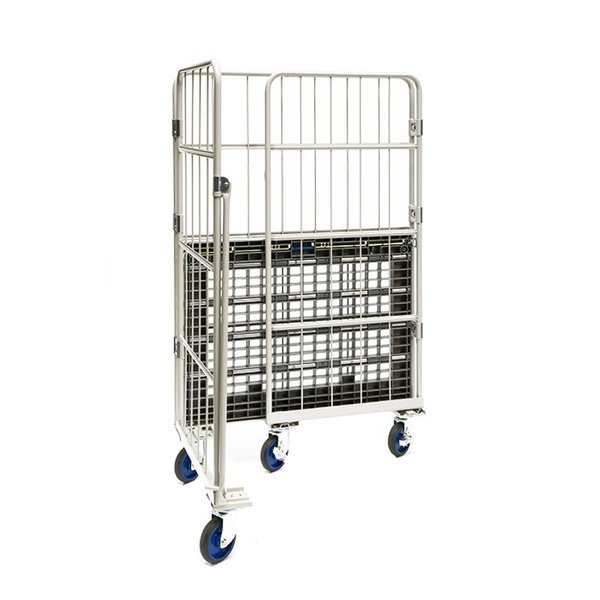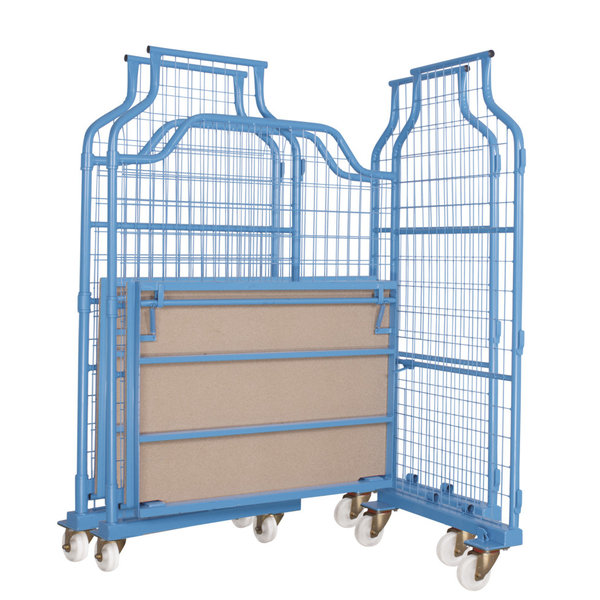How many roll containers fit in a trailer or truck?
In the logistics industry, transporting goods efficiently is critical. Roll containers play an important role in this. Roll containers are often filled or transported empty using a trailer or truck. But how many roll containers fit in a trailer or truck? To answer this question, we need to look at two aspects: a maximum load considering standard (demountable) roll containers, and a maximum load considering nestable roll containers. We also look at the advantages, capacities and space-saving properties of these different types of roll containers.
Roll containers: essential in the supply chain
Roll containers are a crucial transport packaging in the modern supply chain. Due to their versatility and ergonomic design, they have become indispensable in industries such as retail, the medical sector, e-commerce, and moving companies. However, the biggest advantage of roll containers is their space-saving nature when they are not loaded. Standard roll cages and nestable roll cages both provide significant space savings when empty.
Nestable roll containers can also be assembled faster and easier, while standard roll containers require more work to stack but can usually be transported in larger numbers.
Standard roll cages and nestable roll cages
Standard Roll Containers: Fixed Shape & Mountable Fences
When loading standard, non-nestable roll containers into a trailer or truck, the available space is a limiting factor. A 13.6-metre semi-trailer can carry around 60 loaded roll containers, depending on their dimensions (usually 715x805x1800 mm). Trolleys with a fixed shape (not demountable) take up a lot of space, both during transport and storage. As a result, you can transport or store fewer units at the same time, which can lead to higher costs and reduced efficiency. In general, demountable roll containers are slightly lower in cost price than nestable roll containers, but this also depends on the material used and the type of roll trolley.
However, a large part of the roll containers that you can buy at Rotomshop have mountable fences such as plug-in gates or clamping fences. You can easily detach these side walls from the roll bottom, so that you can stack the roll containers. Often a combination will be made of stacks with roll bottoms and roll containers filled with raised fences or side walls. This way you can transport up to about 270 pieces. This is an increase of 350%.
Nestable Roll Containers: ergonomic space-saving
Nestable roll cages are designed to be easy to fold or slide together when not in use. This saves space during storage and return transport and allows for a more efficient supply chain. As with demountable roll containers, the great strength of nestable roll cages is their space-saving feature when not in use. An additional important point is that this type of trolley has a higher ergonomic value. An empty roll container can be nested very quickly and easily by sliding them together, which saves time and energy.
A 13.60m semi-trailer can also accommodate 60 loaded containers, just like standard roll containers. When you start nesting the trolleys, 153, 180 or even 300 roll containers can be transported. This depends on the model used. This allows you to make better use of the available space in your truck by up to 400%. This contributes significantly to reducing transport costs and increasing logistics efficiency.
Different types of nestable Roll Containers: L-frame, A-frame and Flexo
The Rotomshop UK range contains 3 different types of nestable roll containers: roll trolleys with an A-frame, an L-frame and the Flexo roll container.
- A-frame: a simple design in which the roll bottom is folded up, or the walls of the roll cage are folded, and the frame of the roll cage is placed in the shape of the letter A. The roll containers are nested by driving the A-frames together. This type of frame is suitable for businesses that need to work quickly and efficiently.
- L-frame: This design is very similar to the design of an A-frame, but requires more handling when folding up. For example, the bottom must first be folded up, and then a side wall can also be folded. In this way, the frame will be placed in the shape of the letter L. This type of frame is ideal for maximum space saving.
- Flexo: In addition to the traditional nestable roll containers, Rotomshop also offers innovative solutions such as the Flexo. The Flexo is a collapsible roll cage that can be reduced to one-fifth of its original dimensions but can still stand upright. During empty transport, four Flexo roll containers can be folded together to the size of one. These roll containers are ideal for companies that need extra capacity during busy periods without the containers taking up a lot of space in the low season. Combines the advantages of both the A-frames and the L-frames.
  |
  |
  |
| L-frame roll containers | A-frame roll cages | Flexo roll container |
Conclusion
Choosing the right roll container can have a major impact on the efficiency of your logistics processes. When loaded, standard roll cages and nestable roll cages take up the same amount of space. The decisive factors are therefore space-saving capacity on the one hand and ergonomics and efficiency on the other. Standard non-nestable roll cages offer flexibility, and slightly lower purchase costs offer great space-saving capacity. Stacking and dismantling these roll containers requires time and labour, which is less ergonomic and efficient. Nestable roll cages, on the other hand, offer maximum ergonomics and efficiency, at the expense of a smaller space-saving capacity on average.
With the information from this blog, you can find out which type of roll container best suits your specific needs and situation. At Rotomshop, we are happy to help you find the roll container that suits you best. Rotomshop UK is a specialist in load carriers. Contact us today at[email protected] or +44 (0)1777 322 100
